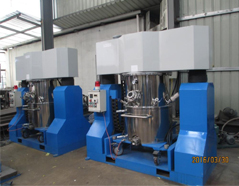
Common faults and troubleshooting methods for planetary mixers
A planetary mixer is composed of a low-speed mixer and a high-speed disperser, and is equipped with components such as a planetary frame, wall scraper, lifting system, material tank, and frame. Due to the high output torque of the planetary mixer, it has excellent mixing, reaction, dispersion, and dissolution effects, making it particularly suitable for processes such as dissolution, mixing, compounding, and reaction of materials ranging from powders to high-viscosity and high-density materials.
When the sun gear rotates, it drives the agitating shaft and dispersing shaft inside the housing to orbit around the axis of the material drum while simultaneously spinning at high speed, thus subjecting the material to strong shearing and kneading, achieving the effect of thorough dispersion and mixing. The scraping blades continuously scrape against the drum wall, pushing the material on the wall toward the center. The hydraulic oil pump controls the lifting or lowering of the frame or drum body, forming a closed mixing and reaction space between the upper and lower drum bodies. After one rotation of the sun gear, the impeller has already spun several times, and after several orbits, most of the material has been mixed. After several more rotations, all the material is completely and evenly mixed.
Understanding the working principle of the planetary mixer allows us to quickly identify the causes of faults based on its principles.
Below, Shanghai Konmix will briefly introduce the common faults of the planetary mixer and their inspection and maintenance methods.
1. Stirring and dispersing for a period of time, then suddenly shut down: A: Check if the stirring and dispersing is turned on during operation, caused by setting the time too short; B: Overload protection;
2. Operating noise: A: Large noise from the reducer (add reducer oil); B: Whether the sprockets/chain are matching smoothly or worn; C: Axle deformation, poor dynamic balance of the dispersing plate; D: Stirring桨 hitting the wall, bottom or clashing
3. Inaccurate temperature measurement: A: Temperature probe damage; B: Check for open circuits in the wiring; C: Check the mold temperature machine/heat oil furnace;
4. Oil leakage: (1): Contact condition of mechanical seal static and dynamic rings. (2): Check if the seal ring is aging/damaged. (3): Check if the oil seal is aging/damaged.
A. Prepare well before the trial run.
B. Check if all components are installed firmly.
C. If theparking time is long, clean the material cylinder and mixing blades.
D. Please refer to the product manual for details.
